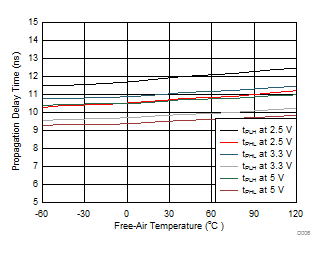SLLSEP1B July 2015 – June 2016 ISO7810
PRODUCTION DATA.
- 1 Features
- 2 Applications
- 3 Description
- 4 Revision History
- 5 Pin Configuration and Functions
-
6 Specifications
- 6.1 Absolute Maximum Ratings
- 6.2 ESD Ratings
- 6.3 Recommended Operating Conditions
- 6.4 Thermal Information
- 6.5 Power Rating
- 6.6 Insulation Characteristics
- 6.7 Regulatory Information
- 6.8 Safety Limiting Values
- 6.9 Electrical Characteristics—5-V Supply
- 6.10 Supply Current Characteristics—5-V Supply
- 6.11 Electrical Characteristics—3.3-V Supply
- 6.12 Supply Current Characteristics—3.3-V Supply
- 6.13 Electrical Characteristics—2.5-V Supply
- 6.14 Supply Current Characteristics—2.5-V Supply
- 6.15 Switching Characteristics—5-V Supply
- 6.16 Switching Characteristics—3.3-V Supply
- 6.17 Switching Characteristics—2.5-V Supply
- 6.18 Insulation Characteristics Curves
- 6.19 Typical Characteristics
- 7 Parameter Measurement Information
- 8 Detailed Description
- 9 Applications and Implementation
- 10Power Supply Recommendations
- 11Layout
- 12Device and Documentation Support
- 13Mechanical, Packaging, and Orderable Information
Package Options
Refer to the PDF data sheet for device specific package drawings
Mechanical Data (Package|Pins)
- DWW|16
- DW|16
Thermal pad, mechanical data (Package|Pins)
- DW|16
Orderable Information
6 Specifications
6.1 Absolute Maximum Ratings
See (1)| MIN | MAX | UNIT | ||||
|---|---|---|---|---|---|---|
| Supply voltage(2) | VCC1, VCC2 | –0.5 | 6 | V | ||
| Voltage | IN, OUT, EN2 | –0.5 | VCC + 0.5(3) | V | ||
| Output current, IO | –15 | 15 | mA | |||
| Junction temperature, TJ | –55 | 150 | °C | |||
| Storage temperature, Tstg | –65 | 150 | °C | |||
6.2 ESD Ratings
| VALUE | UNIT | |||
|---|---|---|---|---|
| VESD | Electrostatic discharge | Human body model (HBM), per ANSI/ESDA/JEDEC JS-001, all pins (1) | ±6000 | V |
| Charged device model (CDM), per JEDEC specification JESD22-C101, all pins(2) | ±1500 | V | ||
6.3 Recommended Operating Conditions
| MIN | NOM | MAX | UNIT | ||||
|---|---|---|---|---|---|---|---|
| VCC1, VCC2 | Supply voltage | 2.25 | 5.5 | V | |||
| IOH | High-level output current | VCC2 = 5 V | –4 | mA | |||
| VCC2 = 3.3 V | –2 | ||||||
| VCC2 = 2.5 V | –1 | ||||||
| IOL | Low-level output current | VCC2 = 5 V | 4 | mA | |||
| VCC2 = 3.3 V | 2 | ||||||
| VCC2 = 2.5 V | 1 | ||||||
| VIH | High-level input voltage | 0.7 × VCC1 | VCC1 | V | |||
| VIL | Low-level input voltage | 0 | 0.3 × VCC1 | V | |||
| tui | Input pulse duration | 7 | ns | ||||
| DR | Signaling rate | 0 | 100 | Mbps | |||
| TA | Ambient temperature | –55 | 25 | 125 | °C | ||
6.4 Thermal Information
| THERMAL METRIC(1) | ISO7810x | UNIT | |||
|---|---|---|---|---|---|
| DW (SOIC) | DWW (SOIC) | ||||
| 16 PINS | 16 PINS | ||||
| RθJA | Junction-to-ambient thermal resistance | 89 | 92.2 | °C/W | |
| RθJC(top) | Junction-to-case(top) thermal resistance | 51.5 | 53.8 | °C/W | |
| RθJB | Junction-to-board thermal resistance | 53.6 | 62.9 | °C/W | |
| ψJT | Junction-to-top characterization parameter | 22.5 | 23.9 | °C/W | |
| ψJB | Junction-to-board characterization parameter | 23.1 | 62.2 | °C/W | |
| RθJC(bottom) | Junction-to-case(bottom) thermal resistance | — | — | °C/W | |
6.5 Power Rating
6.6 Insulation Characteristics
| PARAMETER | TEST CONDITIONS | SPECIFICATION | UNIT | |||
|---|---|---|---|---|---|---|
| DW | DWW | |||||
| CLR | External clearance(1) | Shortest terminal-to-terminal distance through air | >8 | >14.5 | mm | |
| CPG | External creepage (1) | Shortest terminal-to-terminal distance across the package surface | >8 | >14.5 | mm | |
| DTI | Distance through the insulation | Minimum internal gap (internal clearance) | >21 | >21 | μm | |
| CTI | Comparative tracking index | DIN EN 60112 (VDE 0303-11); IEC 60112; UL 746A | >600 | >600 | V | |
| Material group | I | I | ||||
| Overvoltage category per IEC 60664-1 | Rated mains voltage ≤ 600 VRMS | I–IV | I–IV | |||
| Rated mains voltage ≤ 1000 VRMS | I–III | I–IV | ||||
| DIN V VDE V 0884-10 (VDE V 0884-10):2006-12 (2) | ||||||
| VIOTM | Maximum transient isolation voltage | VTEST = VIOTM
t = 60 s (qualification) t= 1 s (100% production) |
8000 | 8000 | VPK | |
| VIOSM | Maximum surge isolation voltage(3) | Test method per IEC 60065, 1.2/50 µs waveform, VTEST = 1.6 × VIOSM = 12800 VPK (qualification) |
8000 | 8000 | VPK | |
| VIORM | Maximum repetitive peak isolation voltage | 2121 | 2828 | VPK | ||
| VIOWM | Maximum isolation working voltage | Time dependent dielectric breakdown (TDDB) test; see Figure 1 and Figure 2 | 1500 | 2000 | VRMS | |
| 2121 | 2828 | VDC | ||||
| VPR | Input-to-output test voltage | Method a, After Input/Output safety test subgroup 2/3, VPR = VIORM × 1.2, t = 10 s, Partial discharge < 5 pC |
2545 | 3394 | VPK | |
| Method a, After environmental tests subgroup 1, VPR = VIORM × 1.6, t = 10 s, Partial Discharge < 5 pC |
3394 | 4525 | ||||
| Method b1,After environmental tests subgroup 1, VPR = VIORM × 1.875, t = 1 s (100% Production test) Partial discharge < 5 pC |
3977 | 5303 | ||||
| CIO | Barrier capacitance, input to output(4) | VIO = 0.4 × sin (2πft), f = 1 MHz | ~0.75 | ~0.75 | pF | |
| RIO | Isolation resistance, input to output(4) | VIO = 500 V, TA = 25°C | >1012 | >1012 | Ω | |
| VIO = 500 V, 100°C ≤ TA ≤ max | >1011 | >1011 | Ω | |||
| RS | Isolation resistance | VIO = 500 V at TS | >109 | >109 | Ω | |
| Pollution degree | 2 | 2 | ||||
| Climatic category | 55/125/21 | 55/125/21 | ||||
| UL 1577 | ||||||
| VISO | Withstanding isolation voltage | VTEST = VISO = 5700 VRMS, t = 60 s (qualification); VTEST = 1.2 × VISO = 6840 VRMS , t = 1 s (100% production) |
5700 | 5700 | VRMS | |
6.7 Regulatory Information
DW package certifications are complete. DWW package certifications completed for UL, VDE, and TUV and planned for CSA and CQC.| VDE | CSA | UL | CQC | TUV |
|---|---|---|---|---|
| Certified according to DIN V VDE V 0884-10 (VDE V 0884-10):2006-12 and DIN EN 60950-1 (VDE 0805 Teil 1):2011-01 | Approved under CSA Component Acceptance Notice 5A, IEC 60950-1 and IEC 60601-1 | Recognized under UL 1577 Component Recognition Program | Certified according to GB 4943.1-2011 | Certified according to EN 61010-1:2010 (3rd Ed) and EN 60950-1:2006/A11:2009/A1:2010/A12:2011/A2:2013 |
| Reinforced insulation Maximum transient isolation voltage, 8000 VPK; Maximum repetitive peak isolation voltage, 2121 VPK(DW package), 2828 VPK (DWW package); Maximum surge isolation voltage, 8000 VPK |
Reinforced insulation per CSA 60950-1-07+A1+A2 and IEC 60950-1 2nd Ed., 800 VRMS max working voltage (pollution degree 2, material group I); |
Single protection, 5700 VRMS | Reinforced Insulation, Altitude ≤ 5000 m, Tropical Climate, 250 VRMS maximum working voltage | 5700 VRMS Reinforced insulation per EN 61010-1:2010 (3rd Ed) up to working voltage of 600 VRMS (DW package) and 1000 VRMS (DWW package) |
| 2 MOPP (Means of Patient Protection) per CSA 60601-1:14 and IEC 60601-1 Ed. 3.1, 250 VRMS (354 VPK) max working voltage |
5700 VRMS Reinforced insulation per EN 60950-1:2006/A11:2009/A1:2010/A12:2011/A2:2013 up to working voltage of 800 VRMS (DW package) and 1450 VRMS (DWW package) | |||
| Certificate number: 40040142 | Master contract number: 220991 | File number: E181974 | Certificate number: CQC15001121716 | Client ID number: 77311 |
6.8 Safety Limiting Values
Safety limiting intends to minimize potential damage to the isolation barrier upon failure of input or output circuitry. A failure of the I/O can allow low resistance to ground or the supply and, without current limiting, dissipate sufficient power to overheat the die and damage the isolation barrier potentially leading to secondary system failures.| PARAMETER | TEST CONDITIONS | MIN | TYP | MAX | UNIT | |
|---|---|---|---|---|---|---|
| DW PACKAGE | ||||||
| IS | Safety input, output, or supply current | RθJA = 89°C/W, VI = 5.5 V, TJ = 150°C, TA = 25°C, see Figure 3 | 255 | mA | ||
| RθJA = 89°C/W, VI = 3.6 V, TJ = 150°C, TA = 25°C, see Figure 3 | 390 | |||||
| RθJA = 89°C/W, VI = 2.75 V, TJ = 150°C, TA = 25°C, see Figure 3 | 511 | |||||
| PS | Safety input, output, or total power | RθJA = 89°C/W, TJ = 150°C, TA = 25°C, see Figure 5 | 1404 | mW | ||
| TS | Maximum safety temperature | 150 | °C | |||
| DWW PACKAGE | ||||||
| IS | Safety input, output, or supply current | RθJA = 92.2°C/W, VI = 5.5 V, TJ = 150°C, TA = 25°C, see Figure 4 | 246 | mA | ||
| RθJA = 92.2°C/W, VI = 3.6 V, TJ = 150°C, TA = 25°C, see Figure 4 | 377 | |||||
| RθJA = 92.2°C/W, VI = 2.75 V, TJ = 150°C, TA = 25°C, see Figure 4 | 493 | |||||
| PS | Safety input, output, or total power | RθJA = 92.2°C/W, TJ = 150°C, TA = 25°C, see Figure 6 | 1356 | mW | ||
| TS | Maximum safety temperature | 150 | °C | |||
The maximum safety temperature is the maximum junction temperature specified for the device. The power dissipation and junction-to-air thermal impedance of the device installed in the application hardware determines the junction temperature. The assumed junction-to-air thermal resistance in the Thermal Information is that of a device installed on a high-K test board for leaded surface mount packages. The power is the recommended maximum input voltage times the current. The junction temperature is then the ambient temperature plus the power times the junction-to-air thermal resistance.
6.9 Electrical Characteristics—5-V Supply
VCC1 = VCC2 = 5 V ± 10% (over recommended operating conditions unless otherwise noted)| PARAMETER | TEST CONDITIONS | MIN | TYP | MAX | UNIT | ||
|---|---|---|---|---|---|---|---|
| VOH | High-level output voltage | IOH = –4 mA; see Figure 13 | VCC2 – 0.4 | VCC2 – 0.2 | V | ||
| VOL | Low-level output voltage | IOL = 4 mA; see Figure 13 | 0.2 | 0.4 | V | ||
| VI(HYS) | Input threshold voltage hysteresis | 0.1 × VCC1 | V | ||||
| IIH | High-level input current | VIH = VCC1 at IN or EN2 | 10 | μA | |||
| IIL | Low-level input current | VIL = 0 V at IN or EN2 | –10 | μA | |||
| CMTI | Common-mode transient immunity | VI = VCC1 or 0 V, VCM = 1500 V; see Figure 16 | 100 | kV/μs | |||
| CI | Input capacitance (1) | VI = VCC/2 + 0.4 × sin (2πft), f = 1 MHz, VCC = 5 V | 2 | pF | |||
6.10 Supply Current Characteristics—5-V Supply
VCC1 = VCC2 = 5 V ± 10% (over recommended operating conditions unless otherwise noted)6.11 Electrical Characteristics—3.3-V Supply
VCC1 = VCC2 = 3.3 V ± 10% (over recommended operating conditions unless otherwise noted)| PARAMETER | TEST CONDITIONS | MIN | TYP | MAX | UNIT | ||
|---|---|---|---|---|---|---|---|
| VOH | High-level output voltage | IOH = –2 mA; see Figure 13 | VCC2 – 0.4 | VCC2 – 0.2 | V | ||
| VOL | Low-level output voltage | IOL = 2 mA; see Figure 13 | 0.2 | 0.4 | V | ||
| VI(HYS) | Input threshold voltage hysteresis | 0.1 × VCC1 | V | ||||
| IIH | High-level input current | VIH = VCC1 at IN or EN2 | 10 | μA | |||
| IIL | Low-level input current | VIL = 0 V at IN or EN2 | –10 | μA | |||
| CMTI | Common-mode transient immunity | VI = VCC1 or 0 V, VCM = 1500 V; see Figure 16 | 100 | kV/μs | |||
6.12 Supply Current Characteristics—3.3-V Supply
VCC1 = VCC2 = 3.3 V ± 10% (over recommended operating conditions unless otherwise noted)| PARAMETER | TEST CONDITIONS | SUPPLY CURRENT | MIN | TYP | MAX | UNIT | |
|---|---|---|---|---|---|---|---|
| Supply current - disable (DWW package only) |
EN2 = 0 V, VI = 0 V (Devices with suffix F), VI = VCC1 (Devices without suffix F) |
ICC1 | 0.6 | 1.1 | mA | ||
| ICC2 | 0.16 | 0.3 | |||||
| EN2 = 0 V, VI = VCC1 (Devices with suffix F), VI = 0 V (Devices without suffix F) |
ICC1 | 1.8 | 2.7 | ||||
| ICC2 | 0.16 | 0.3 | |||||
| Supply current - DC signal | VI = 0 V (Devices with suffix F), VI = VCC1 (Devices without suffix F) |
ICC1 | 0.6 | 1.1 | mA | ||
| ICC2 | 0.6 | 1 | |||||
| VI = VCC1 (Devices with suffix F), VI = 0 V(Devices without suffix F) |
ICC1 | 1.8 | 2.7 | ||||
| ICC2 | 0.6 | 1.1 | |||||
| Supply current - AC signal | Input signal switching with square wave clock input; CL = 15 pF |
1 Mbps | ICC1 | 1.2 | 1.9 | mA | |
| ICC2 | 0.6 | 1.1 | |||||
| 10 Mbps | ICC1 | 1.2 | 1.9 | ||||
| ICC2 | 0.9 | 1.4 | |||||
| 100 Mbps | ICC1 | 1.3 | 2 | ||||
| ICC2 | 4.1 | 5.4 | |||||
6.13 Electrical Characteristics—2.5-V Supply
VCC1 = VCC2 = 2.5 V ± 10% (over recommended operating conditions unless otherwise noted)| PARAMETER | TEST CONDITIONS | MIN | TYP | MAX | UNIT | ||
|---|---|---|---|---|---|---|---|
| VOH | High-level output voltage | IOH = –1 mA; see Figure 13 | VCC2 – 0.4 | VCC2 – 0.2 | V | ||
| VOL | Low-level output voltage | IOL = 1 mA; see Figure 13 | 0.2 | 0.4 | V | ||
| VI(HYS) | Input threshold voltage hysteresis | 0.1 x VCC1 | V | ||||
| IIH | High-level input current | VIH = VCC1 at IN or EN2 | 10 | μA | |||
| IIL | Low-level input current | VIL = 0 V at IN or EN2 | –10 | μA | |||
| CMTI | Common-mode transient immunity | VI = VCC1 or 0 V, VCM = 1500 V; see Figure 16 | 100 | kV/μs | |||
6.14 Supply Current Characteristics—2.5-V Supply
VCC1 = VCC2 = 2.5 V ± 10% (over recommended operating conditions unless otherwise noted)| PARAMETER | TEST CONDITIONS | SUPPLY CURRENT | MIN | TYP | MAX | UNIT | |
|---|---|---|---|---|---|---|---|
| Supply current, - disable (DWW package only) |
EN2 = 0 V, VI = 0 V (Devices with suffix F), VI = VCC1 (Devices without suffix F) |
ICC1 | 0.6 | 1.1 | mA | ||
| ICC2 | 0.16 | 0.3 | |||||
| EN2 = 0 V, VI = VCC1 (Devices with suffix F), VI = 0 V (Devices without suffix F) |
ICC1 | 1.8 | 2.7 | ||||
| ICC2 | 0.16 | 0.3 | |||||
| Supply current - DC signal | VI = 0 V (Devices with suffix F), VI = VCCx (Devices without suffix F) |
ICC1 | 0.6 | 1.1 | mA | ||
| ICC2 | 0.6 | 1 | |||||
| VI = VCCx (Devices with suffix F), VI = 0 V(Devices without suffix F) |
ICC1 | 1.8 | 2.7 | ||||
| ICC2 | 0.6 | 1.1 | |||||
| Supply current - AC signal | Input signal switching with square wave clock input; CL = 15 pF |
1 Mbps | ICC1 | 1.2 | 1.9 | mA | |
| ICC2 | 0.6 | 1.1 | |||||
| 10 Mbps | ICC1 | 1.2 | 1.9 | ||||
| ICC2 | 0.9 | 1.3 | |||||
| 100 Mbps | ICC1 | 1.3 | 2 | ||||
| ICC2 | 3.3 | 4.4 | |||||
6.15 Switching Characteristics—5-V Supply
VCC1 = VCC2 = 5 V ± 10% (over recommended operating conditions unless otherwise noted)| PARAMETER | TEST CONDITIONS | MIN | TYP | MAX | UNIT | ||
|---|---|---|---|---|---|---|---|
| tPLH, tPHL | Propagation delay time | See Figure 13 | 6 | 10.7 | 16 | ns | |
| PWD | Pulse width distortion(1) |tPHL – tPLH| | 0.6 | 4.6 | ns | |||
| tsk(pp) | Part-to-part skew time(2) | 4.5 | ns | ||||
| tr | Output signal rise time | See Figure 13 | 2.4 | 3.9 | ns | ||
| tf | Output signal fall time | 2.4 | 3.9 | ns | |||
| tPHZ | Disable propagation delay, high-to-high impedance output for ISO7810DWW and ISO7810FDWW | See Figure 14 | 12 | 20 | ns | ||
| tPLZ | Disable propagation delay, low-to-high impedance output for ISO7810DWW and ISO7810FDWW | 12 | 20 | ns | |||
| tPZH | Enable propagation delay, high impedance-to-high output |
ISO7810DWW | 10 | 20 | ns | ||
| ISO7810FDWW | 2 | 2.5 | μs | ||||
| tPZL | Enable propagation delay, high impedance-to-low output |
ISO7810DWW | 2 | 2.5 | μs | ||
| ISO7810FDWW | 10 | 20 | ns | ||||
| tDO | Default output delay time from input power loss | Measured from the time VCC goes below 1.7 V. See Figure 15 | 0.2 | 9 | μs | ||
| tie | Time interval error | 216 – 1 PRBS data at 100 Mbps | 1 | ns | |||
6.16 Switching Characteristics—3.3-V Supply
VCC1 = VCC2 = 3.3 V ± 10% (over recommended operating conditions unless otherwise noted)| PARAMETER | TEST CONDITIONS | MIN | TYP | MAX | UNIT | ||
|---|---|---|---|---|---|---|---|
| tPLH, tPHL | Propagation delay time | See Figure 13 | 6 | 10.8 | 16 | ns | |
| PWD | Pulse width distortion(1) |tPHL – tPLH| | 0.7 | 4.7 | ns | |||
| tsk(pp) | Part-to-part skew time(2) | 4.5 | ns | ||||
| tr | Output signal rise time | See Figure 13 | 1.3 | 3 | ns | ||
| tf | Output signal fall time | 1.3 | 3 | ns | |||
| tPHZ | Disable propagation delay, high-to-high impedance output for ISO7810DWW and ISO7810FDWW | See Figure 14 | 17 | 32 | ns | ||
| tPLZ | Disable propagation delay, low-to-high impedance output for ISO7810DWW and ISO7810FDWW | 17 | 32 | ns | |||
| tPZH | Enable propagation delay, high impedance-to-high output |
ISO7810DWW | 17 | 32 | ns | ||
| ISO7810FDWW | 2 | 2.5 | μs | ||||
| tPZL | Enable propagation delay, high impedance-to-low output |
ISO7810DWW | 2 | 2.5 | μs | ||
| ISO7810FDWW | 17 | 32 | ns | ||||
| tDO | Default output delay time from input power loss | Measured from the time VCC goes below 1.7 V. See Figure 15 | 0.2 | 9 | μs | ||
| tie | Time interval error | 216 – 1 PRBS data at 100 Mbps | 1 | ns | |||
6.17 Switching Characteristics—2.5-V Supply
VCC1 = VCC2 = 2.5 V ± 10% (over recommended operating conditions unless otherwise noted)| PARAMETER | TEST CONDITIONS | MIN | TYP | MAX | UNIT | ||
|---|---|---|---|---|---|---|---|
| tPLH, tPHL | Propagation delay time | See Figure 13 | 7.5 | 11.7 | 17.5 | ns | |
| PWD | Pulse width distortion(1) |tPHL – tPLH| | 0.7 | 4.7 | ns | |||
| tsk(pp) | Part-to-part skew time(2) | 4.5 | ns | ||||
| tr | Output signal rise time | See Figure 13 | 1.8 | 3.5 | ns | ||
| tf | Output signal fall time | 1.8 | 3.5 | ns | |||
| tPHZ | Disable propagation delay, high-to-high impedance output for ISO7810DWW and ISO7810FDWW | See Figure 14 | 22 | 45 | ns | ||
| tPLZ | Disable propagation delay, low-to-high impedance output for ISO7810DWW and ISO7810FDWW | 22 | 45 | ns | |||
| tPZH | Enable propagation delay, high impedance-to-high output |
ISO7810DWW | 18 | 45 | ns | ||
| ISO7810FDWW | 2 | 2.5 | μs | ||||
| tPZL | Enable propagation delay, high impedance-to-low output |
ISO7810DWW | 2 | 2.5 | μs | ||
| ISO7810FDWW | 18 | 45 | ns | ||||
| tDO | Default output delay time from input power loss | Measured from the time VCC goes below 1.7 V. See Figure 15 | 0.2 | 9 | μs | ||
| tie | Time interval error | 216 – 1 PRBS data at 100 Mbps | 1 | ns | |||
6.18 Insulation Characteristics Curves
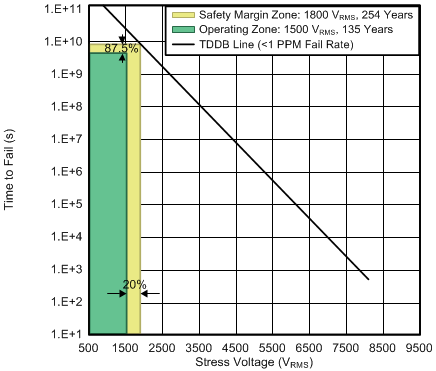
| TA upto 150°C | Operating lifetime = 135 years | |
| Stress-voltage frequency = 60 Hz | ||
| Isolation working voltage = 1500 VRMS | ||
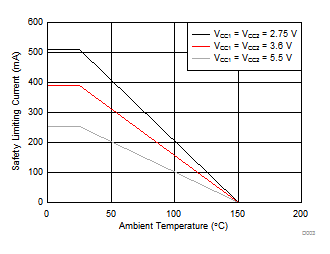 Figure 3. Thermal Derating Curves for Safety Limiting Current for DW Package
Figure 3. Thermal Derating Curves for Safety Limiting Current for DW Package
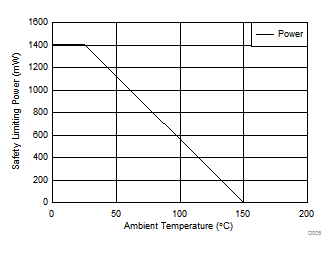 Figure 5. Thermal Derating Curve for Safety Limiting Power for DW Package
Figure 5. Thermal Derating Curve for Safety Limiting Power for DW Package
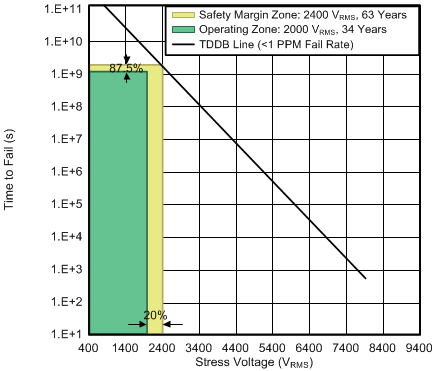
| TA upto 150°C | Operating lifetime = 34 years | |
| Stress-voltage frequency = 60 Hz | ||
| Isolation working voltage = 2000 VRMS | ||
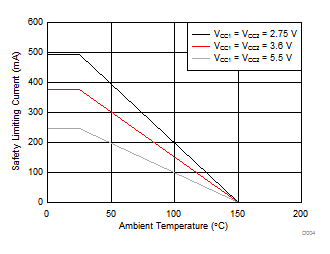 Figure 4. Thermal Derating Curves for Safety Limiting Current for DWW Package
Figure 4. Thermal Derating Curves for Safety Limiting Current for DWW Package
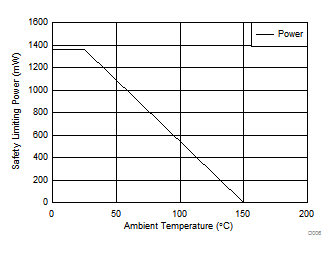 Figure 6. Thermal Derating Curve for Safety Limiting Power for DWW Package
Figure 6. Thermal Derating Curve for Safety Limiting Power for DWW Package
6.19 Typical Characteristics
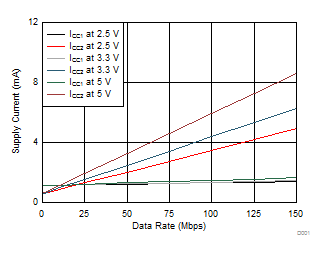
| TA = 25°C | CL = 15 pF |
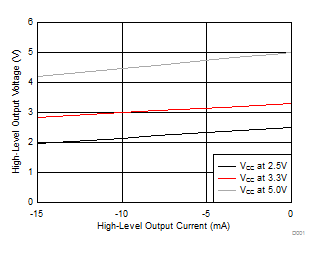
| TA = 25°C |
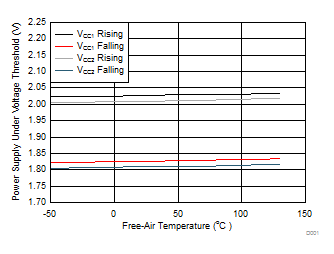
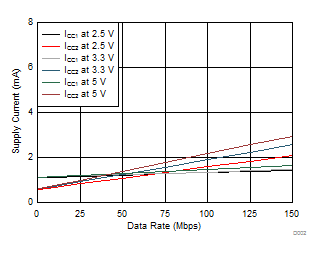
| TA = 25°C | CL = No Load |
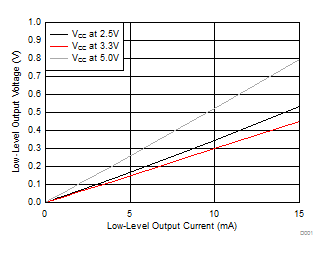
| TA = 25°C |
